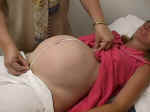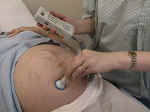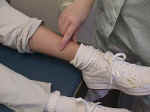|
|
Operational Obstetrics & Gynecology
Normal Pregnancy
At the first prenatal visit, take a careful history, looking for factors that might increase the risk for the pregnant woman. Many providers use a questionnaire, filled out by the patient, as a starting point for this evaluation. A sample Prenatal Registration and Obstetrical Questionnaire form can be used for this purpose.
One important aspect of prenatal care is education of the pregnant woman about her pregnancy, danger signs, things she should do and things she should not do. Many providers find it useful to give the woman printed material covering these issues that she can take with her. This allows her to read the material at a later time and to refer to it whenever she has questions. A sample Prenatal Information form can be printed and used.
Routine visits:
- every 4 weeks until 28 weeks' gestation
- every 2-3 weeks until 36 weeks' gestation
- every week from 36 weeks to delivery
At each prenatal visit:
Check weight
Typical weight gain is about a pound a week. This means 30 to 40 pounds for the entire pregnancy, although some physicians feel the ideal weight gain should be closer to 25 pounds. Weight gain is usually slow during the first 20 weeks. Then, there is usually rapid weight gain from 20 to 32 weeks. After that, weight gain generally slows and there may be little, if any weight gain during the last few weeks.
If there is insufficient weight gain (below 13 pounds), there is concern that the baby may not be getting enough food. If there is sudden weight gain (more than 2 pounds in a week or more than 6 pounds in a month), this may be associated with the development of fluid retention due to pre-eclampsia (toxemia of pregnancy).
Check blood pressure
Blood pressure in early pregnancy will reflect pre-pregnancy levels. During the 2nd trimester, maternal blood pressures usually fall below prepregnancy levels. During the 3rd trimester, blood pressure usually goes back up to the pre-pregnancy level. Any sustained BP of 140/90 or greater is considered significant and may indicate the development of pre-eclampsia.
Use a tape measure to record the size of the uterus (technique described below). The fundal height, measured in cm, should be approximately equal to the weeks gestation, from mid-pregnancy until near term. Measurements falling within 1-3 cm of the expected value are considered normal. Fundal heights 4 cm different than expected are considered abnormal and suggest the need for further investigation.
The normal rate is generally considered to be between 120 and 160 beats per minute. The rates are typically higher (140-160) in early pregnancy, and lower (120-140) toward the end of pregnancy. Past term, some normal fetal heart rates fall to 110 BPM. There is no correlation between heart rate and the gender of the fetus.
Swelling of the feet, ankles and hands is common during pregnancy. It can be uncomfortable for the patient, but she can be reassured that it will go away after delivery. Facial edema or any sudden increase in edema can be a sign of developing pre-eclampsia, so the BP should be checked.
An effective treatment for edema is bedrest for 2-3 days, while drinking plenty of plain water and avoiding excessive salt. This will mobilize the extracellular salt and fluids, leading to a loss of several pounds through urination. In most cases, such treatment is not necessary as the edema itself is not medically threatening.
Check protein and glucose
A urine dipstick test for protein is generally negative or trace during pregnancy. If 1+ (30 mg/dl) or more, it is considered significant.
Urine normally shows negative or trace glucose. If persistently 1/4 (250 gm/dl) or more, it is considered significant.
Ask about fetal activity
Although fetal movement can be documented by ultrasound as early as 7-8 weeks of pregnancy, fetal movement is not usually felt by the mother until the 16th week (for women who have delivered a baby) to the 20th week (for women pregnant for the first time).
Once they positively identify fetal movement, most women will acknowledge that they have been feeling the baby move for a week or two, but didn't realize that the sensation (fluttery movements) was from the baby.
Movements generally increase in strength and frequency through pregnancy, particularly at night, when the woman is at rest. At the end of pregnancy (36 weeks and beyond), there is normally a slow change in movements, with fewer violent kicks and more rolling and stretching fetal movements. A sudden decrease in fetal movement is a danger sign that needs to be reported and investigated immediately.
"Kick counts" are sometimes recommended to patients as a means of quantifying fetal movement. One common way of doing a kick count is to ask the woman to count each distinct fetal movement, starting from the time she awakens in the morning. When she reaches 10 movements or kicks, she is done counting for the day. If she gets to 12 noon and hasn't reached a count of 10 movements, she reports this to her provider and further testing is done.
Any new symptoms
A pregnant woman should eat a normal, balanced diet for one person.
This may prove difficult, particularly during the early part of the pregnancy when she may experience significant nausea.
It may also prove difficult later in pregnancy when she feels hungry all the time. These women may find they do better by having more frequent (but smaller) meals, or snacks between meals of relatively nutritious but low caloric foods.
Prenatal Vitamins
It is customary for pregnant women to take a prenatal vitamin each day.
In theory, it might be possible for a pregnant woman to obtain the right amount of essential vitamins and minerals through a careful and complete diet. In real life, it is difficult for most women to achieve such a diet, particularly the need for Folate. It is far simpler take a prenatal vitamin each day.
Those living in nutritionally-deprived areas will particularly benefit from the addition of prenatal vitamins to their diet.
Although the fetal heart begins beating as early as the 5th week after the LMP, your ability to detect it will be limited by your equipment.
An ultrasound machine usually will see a heartbeat by 5 to 6 weeks gestation if equipped with a vaginal probe. Abdominal ultrasound will usually see the heartbeat by the 7th-8th week of pregnancy.
If you use a Doppler ultrasound fetal heartbeat detector, you can, with effort, usually hear the heartbeat by 12-14 weeks gestation and routinely after that.
Using a DeLee stethoscope (equipped with a head-mount), you can sometimes hear the heartbeat by 16 weeks but unless you are practiced with it, you won't hear it until 20 weeks, at which time the mother can usually tell you that she feels the baby moving.
Using a conventional stethoscope, you may never hear the fetal heartbeat.
Pregnancy causes many changes in women, not the least of which are change in weight and its' distribution, balance and increased vulnerability of ligaments and joints to stress. Because of these changes, the safe care of pregnant women requires that their normal work activities be modified. In the Navy, OPNAVINST 6000.1A is the instruction which provides the greatest detail of guidance for the administrative aspects of managing this disability. In the Marine Corps, MCO 5000.12d gives equivalent guidance.
Home · Introduction · Medical Support of Women in Field Environments · The Prisoner of War Experience · Routine Care · Pap Smears · Human Papilloma Virus · Contraception · Birth Control Pills · Vulvar Disease · Vaginal Discharge · Abnormal Bleeding · Menstrual Problems · Abdominal Pain · Urination Problems · Menopause · Breast Problems · Sexual Assault · Normal Pregnancy · Abnormal Pregnancy · Normal Labor and Delivery · Problems During Labor and Delivery · Care of the Newborn
|
Bureau of Medicine
and Surgery |
Operational
Obstetrics & Gynecology - 2nd Edition |
This web version of Operational Obstetrics & Gynecology is provided by The Brookside Associates Medical Education Division. It contains original contents from the official US Navy NAVMEDPUB 6300-2C, but has been reformatted for web access and includes advertising and links that were not present in the original version. This web version has not been approved by the Department of the Navy or the Department of Defense. The presence of any advertising on these pages does not constitute an endorsement of that product or service by either the Department of Defense or the Brookside Associates. The Brookside Associates is a private organization, not affiliated with the United States Department of Defense. All material in this version is unclassified.
This formatting © 2006
Medical Education Division,
Brookside Associates, Ltd.
All rights reserved


